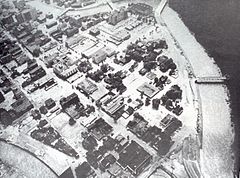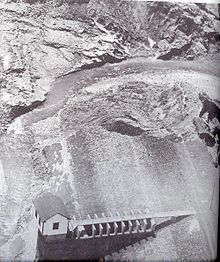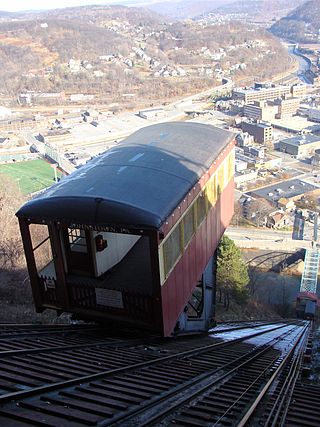
Cambria County is a county in the Commonwealth of Pennsylvania. As of the 2020 census, the population was 133,472. Its county seat is Ebensburg. The county was created on March 26, 1804, from parts of Bedford, Huntingdon, and Somerset counties and later organized in 1807. It was named for the nation of Wales, which in Latin is known as "Cambria".

Johnstown is the largest city in Cambria County, Pennsylvania, United States. The population was 18,411 as of the 2020 census. Located 57 miles (92 km) east of Pittsburgh, it is the principal city of the Johnstown metropolitan area, which is located in Cambria County and had 133,472 residents in 2020. It is also part of the Johnstown–Somerset combined statistical area, which includes both Cambria and Somerset Counties.

Summerhill is a borough in Cambria County, Pennsylvania, United States. The population was 490 at the 2010 census.

The Johnstown Flood, sometimes referred to locally as Great Flood of 1889, occurred on Friday, May 31, 1889, after the catastrophic failure of the South Fork Dam, located on the south fork of the Little Conemaugh River, 14 miles (23 km) upstream of the town of Johnstown, Pennsylvania, United States. The dam ruptured after several days of extremely heavy rainfall, releasing 14.55 million cubic meters of water. With a volumetric flow rate that temporarily equaled the average flow rate of the Mississippi River, the flood killed 2,208 people and accounted for US$17,000,000 in damage.

The Johnstown Flood National Memorial is a unit of the United States National Park Service. Established in 1964 through legislation signed by President Lyndon B. Johnson, it pays tribute to the thousands of victims of the Johnstown Flood, who were injured or killed on May 31, 1889 when the South Fork Dam ruptured.

The Conemaugh River is a 70-mile (110 km) long tributary of the Kiskiminetas River in Westmoreland, Indiana, and Cambria counties in the U.S. state of Pennsylvania. The name means 'Otter Creek', originating from the Unami-Lenape language word kwənəmuxkw 'otter'.
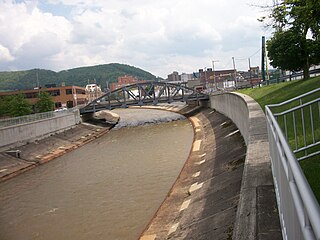
The Little Conemaugh River is a tributary of the Conemaugh River, approximately 30 miles (48 km) long, in western Pennsylvania in the United States.

The Stonycreek River is a tributary of the Conemaugh River, approximately 45 mi (72 km) long, in southwestern Pennsylvania in the United States.

Kelly Barnes Dam was an earthen embankment dam in Stephens County, Georgia, just outside the city of Toccoa. Heavy rainfall caused it to collapse on November 6, 1977, and the resulting flood killed 39 people and caused $2.8 million in damage. The dam was never rebuilt.

Oroville Dam is an earthfill embankment dam on the Feather River east of the city of Oroville, California, in the Sierra Nevada foothills east of the Sacramento Valley. At 770 feet (235 m) high, it is the tallest dam in the U.S. and serves mainly for water supply, hydroelectricity generation, and flood control. The dam impounds Lake Oroville, the second-largest reservoir in California, capable of storing more than 3.5 million acre-feet (1.1×10^12 US gal; 4.3×109 m3).
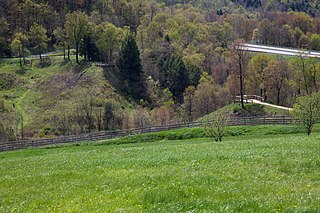
The South Fork Dam was an earthenwork dam forming Lake Conemaugh, an artificial body of water near South Fork, Pennsylvania, United States. On May 31, 1889, the South Fork Dam failed catastrophically and 20 million tons of water from Lake Conemaugh burst through and raced 14 miles (23 km) downstream, causing the Johnstown Flood.

Table Rock Lake is an artificial lake or reservoir in the Ozarks of southwestern Missouri and northwestern Arkansas in the United States. Designed, built and operated by the U.S. Army Corps of Engineers, the lake is impounded by Table Rock Dam, which was constructed from 1954 to 1958 on the White River.
The Quemahoning Reservoir, also known to locals as The Dam, is created by the Quemahoning Dam, located on Quemahoning Creek on the border of Quemahoning Township, Conemaugh Township, and Jenner Township in Somerset County, Pennsylvania just south of Hollsopple.

The South Fork Fishing and Hunting Club was a Pennsylvania corporation that operated an exclusive and secretive retreat at a mountain lake near South Fork, Pennsylvania, for more than 50 extremely wealthy men and their families.

The Cambria Iron Company of Johnstown, Pennsylvania was a major 19th-century industrial producer of iron and steel founded in 1852. The company had the nation's largest steel foundry in the 1870s and was renamed the Cambria Steel Company in 1898. The company used many innovations in the steelmaking process, including those of William Kelly and Henry Bessemer. The company was acquired in 1923 by the Bethlehem Steel Company. The company's historic facilities, extending some 12 miles (19 km) along the Conemaugh and Little Conemaugh Rivers, are a National Historic Landmark District.

Daniel Johnson Morrell was a Republican member of the U.S. House of Representatives from Pennsylvania.

The Laurel Run Dam, also known as Laurel Run Dam No. 2, was an earthen embankment dam that failed during the Johnstown Flood of 1977. It had the largest reservoir of seven dams to fail between July 19 and 20, 1977 and caused the most fatalities of the two that did. The dam failed in the early morning of July 20 after period of heavy rain, causing 101 million US gallons (380,000 m3) of water to flood downstream Tanneryville, killing 40 people.
The Johnstown flood of 1936, also collectively with other areas referred to as the Saint Patrick's Day Flood, was a devastating flood in Cambria County, and Johnstown, Pennsylvania proper, referred to as "Greater Johnstown".
